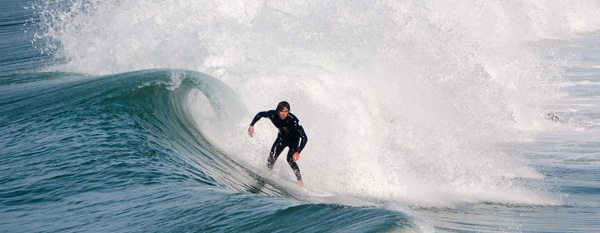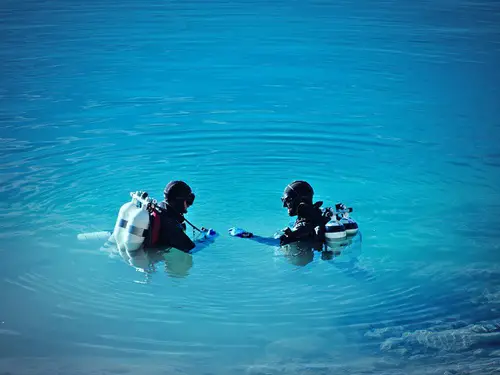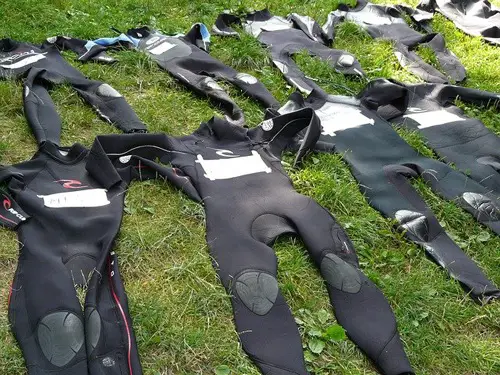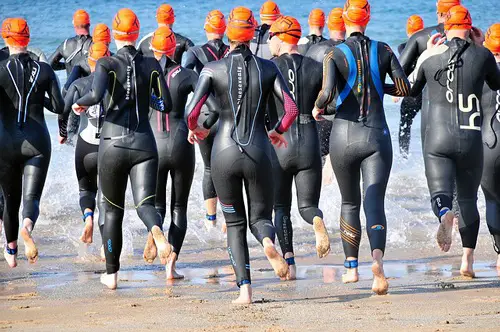Wetsuits – What to Know About Them

What are wetsuits? Since the early fifties, the wetsuit has become the divers and surfers best friend! The snug, form-fitting suit with typical neoprene insulation has many benefits and used in many water sports.
First invented in 1952 to provide protection, warmth, and comfort to water participants. An added benefit to a wetsuit is added buoyancy and protection from certain types of marine life.
1. Wetsuits and Sporting Activities

Underwater diving is a natural sport for wetsuit, but there are many more sport activities for the wetsuit.
Sailing in inclement weather, cold water surfing, white water rafting, and many other activities. Perhaps one of the most important applications for a wet suit is rescue swimming. Saving lives in frigid waters under demanding conditions makes wetsuits a necessity.
A wetsuit can be used in other various activities and Australian water sports like: snorkeling, sea kayaking, swimming at the beach, spearfishing, scuba diving, surf fishing, on a jet ski, water skiing, knee boarding, body boarding, triathlons, wind surfing, paddle boarding, beach combing, to name a few.

2. Benefits to Wearing a Wetsuit
There are numerous benefits to wearing a wetsuit including additional buoyancy. The wetsuit is not an alternative to a life jacket, but the neoprene design adds additional floatation. An added benefit may be reduced stress due to extra floatation and reduced fatigue.
The tight sealing design of a wetsuit may have an extra benefit besides keeping warm and dry in frigid waters. The better sealed a wet suit the more efficient it becomes while delivering a bonus benefit, compression!
The tight design automatically creates compression, and this may assist in increased performance. While on performance, speed swimmers a wear wetsuit to become more “slippery” and thereby becoming faster with less water resistance. Triathlon wetsuits are also getting more high tech.
Other benefits for wearing a wetsuit include:
Protection against stinging jellyfish, like the Blue bottle.
Protection against sunburn.
Keeping warm.
Protection against sand and bits coral when getting knocked about by waves.

3. Wetsuit Designs and Styles
There are many variations of wetsuit designs and styles, like: short sleeve, long sleeve, wetsuit shorts, wetsuit tops, one piece, two piece, Zip at back design, Zip at front on side, farmer John design, etc. Males, females and kid’s wetsuits, etc. These designs will depend on the water sport and activity.
Basically though, there are two common types of wetsuit, fullsuit and spring suits:
- Fullsuit.
The fullsuit is a type of wetsuit that covers the entire body except for the
head, hands, and feet. When immersed in frigid waters, they may require an
additional head cover, gloves, and booties.
A fullsuit comes in a variety of thicknesses from 2mm to 5mm. There also may be
multiple configurations with or without long sleeves, short sleeves, or no
sleeves.
The 2 mm is worn in warmer conditions like W.A. or Queensland or on hotter Aussie days.
For scuba diving in cold southern Victorian and Tasmanian, Australian waters, a 7mm wetsuit two piece might be worn. The cheaper thicker suits are very limiting in mobility. (Trust me, trying to pull a crayfish out of a crevice is hard work in a cheap wetsuit.) A better quality wetsuit is more flexible for snorkeling and scuba diving.
B. Spring Suit.
Designed for cool waters, the spring suit has fewer options since it is more specific in usage. The suit typically has short arms and legs with 2mm thickness or less. Options may include long arms or no arms depending on intended
utilization and water conditions.
4. Wetsuit Brands
There are many assorted wetsuit brands to choose from, like: O’Neil wetsuits, Billabong wetsuits, Rip Curl, Anchor Wetsuits, Orca, Peak Wetsuits, Roxy wetsuits, Buell wetsuits, Anchor wetsuits, Hurley wetsuits, Zion wetsuits, Patagonia wetsuits, etc. You can even get Kmart wetsuits, Anaconda and BCF wetsuit brands.
Here are some of the most popular brands and include their best wetsuit features.
A. RIP CURL FLASHBOMB 3/2 CHEST ZIP.
Ideal for surfers and extreme water enthusiasts, this suit is highly rated. Easy to get into with very flexible neoprene, it is comfortable and very warm. Superior warmth is provided by the latest E5 Flashlining technology.
B. OLAIAN MEN’S SURFING 4/3MM NEOPRENE WETSUIT 100.
With a very attractive price point, the Olain wetsuit is perfect for occasional or begging surfers and water enthusiasts. With a respectful rating for an hour in “cold water”, the affordable price point makes this brand worth a good look.
C. FINISTERRE NIEUWLAND 3E.
An ideal wetsuit for women and perfect for surfing in cold waters. Constructed of Yulex natural rubber, it is designed with special tricks for women to keep warmth in and cold out.
Specially designed wrist seals, custom neck patterns, with higher chest and back pile all work in combination to provide a very comfortable and warm experience.
D. XCEL POLAR THERMOFLEX TDC DIVE FULLSUIT.
The Xcel Fullsuit is designed with cutting-edge technology for deep diving in frigid waters. Made from very thick ultra-stretch neoprene material, this suit is loaded with deep-diving technology.
Their slippery Glideskin material is applied to selected access points for ease of donning the suit. The Polar Protection System zip provides easier entry into this thick diving suit. The Polar TDC has the smart Thermo Dry Celliant technology with hydrophobic linings for extremely frigid waters.
E. 2XU P:1 PROPEL.
This laminated, sponge rubber suit is designed for maximum stretch and athletes. Perfect for triathlons, the special design for this wet suit provides maximum performance with Super Composite Skin technology.
SCS sheds water more easily thereby increasing swimming performance and speed times. With extreme stretching capability, the Propel suit is very easy for the triathlete to exit and transition to other events such as bike riding.
5. Wetsuit Colors and Fashions
The most dominant color for a wetsuit is black for a variety of reasons. Black is less expensive to manufacture, blocks UV rays, more durable, and when in doubt it is the go-to color.
Fortunately, for those that are fashion conscious, a variety of colorful suits are available. Colorful wetsuits under the right circumstances may provide more than style.
A wetsuit may have certain color patterns to make researchers more identifiable while underwater. Rescue operations may be facilitated quicker for divers in colorful suits with easier water detection.
The color of a wet suit may only be limited by imagination. They come in grey, white, black, red, yellow and another color imagined. Some colored suits are designed with certain multi-color patterns to confuse underwater predators, including sharks. (I won’t test that theory though, any volunteers?)
6. Wetsuit Construction
When considering a wet suit, there are many decisions to be made including how the wet suit is constructed.
The various construction components to consider are seams, zippers, and neoprene lining.
A. Seam Types.
1. Overlock – Typically found on less expensive and cheaper suits, the overlock stitch is the most simple and least desirable stitching method.
2. Flatlock – The most common stitching method that is best suited for entry- level suits and warmer waters due to stitching hole leaks.
3. Blindstitch – A more preferred seam style with layers glued then partially stitched ensuring a strong, waterproof seal. Typically found on better suits for cold water diving.
4. Welded – Typically found on a higher-end wetsuit, a silico-based seal that provides an extremely flexible and waterproof seal.
B. Zippers.
1. Back Zip – Most common zipper found in a wetsuit that zips from the base of the spine up to the neck. The back zip reduces spine flexibility and provides an opportunity for water to flush through.
2. Chest Zip – The chest zip provides a shorter zip length in front and more flexibility. There may be less water flushing but a trade-off with time for
entry.
3. Zip Free – Maximum flexibility for entry without any zipper with less weight. They provide a better seal with a resultant higher warmth factor and lighter weight.
Conclusion – Choosing a Wetsuit
The purpose of this article is how to make better-informed decisions when investing your hard-earned dollar. There are many variables to be considered, but this is a very good starting point.
The old saying “one size does not fit all” certainly applies here.
For the beginner or occasionally water sports enthusiast, an entry-level may be the best choice. However, for the hard-core sports demon that loves thrills, money should not be the deciding factor.
When choosing your wetsuit, choose wisely based upon your needs. Your enjoyment of the sport may be greatly enhanced with an informed decision.
